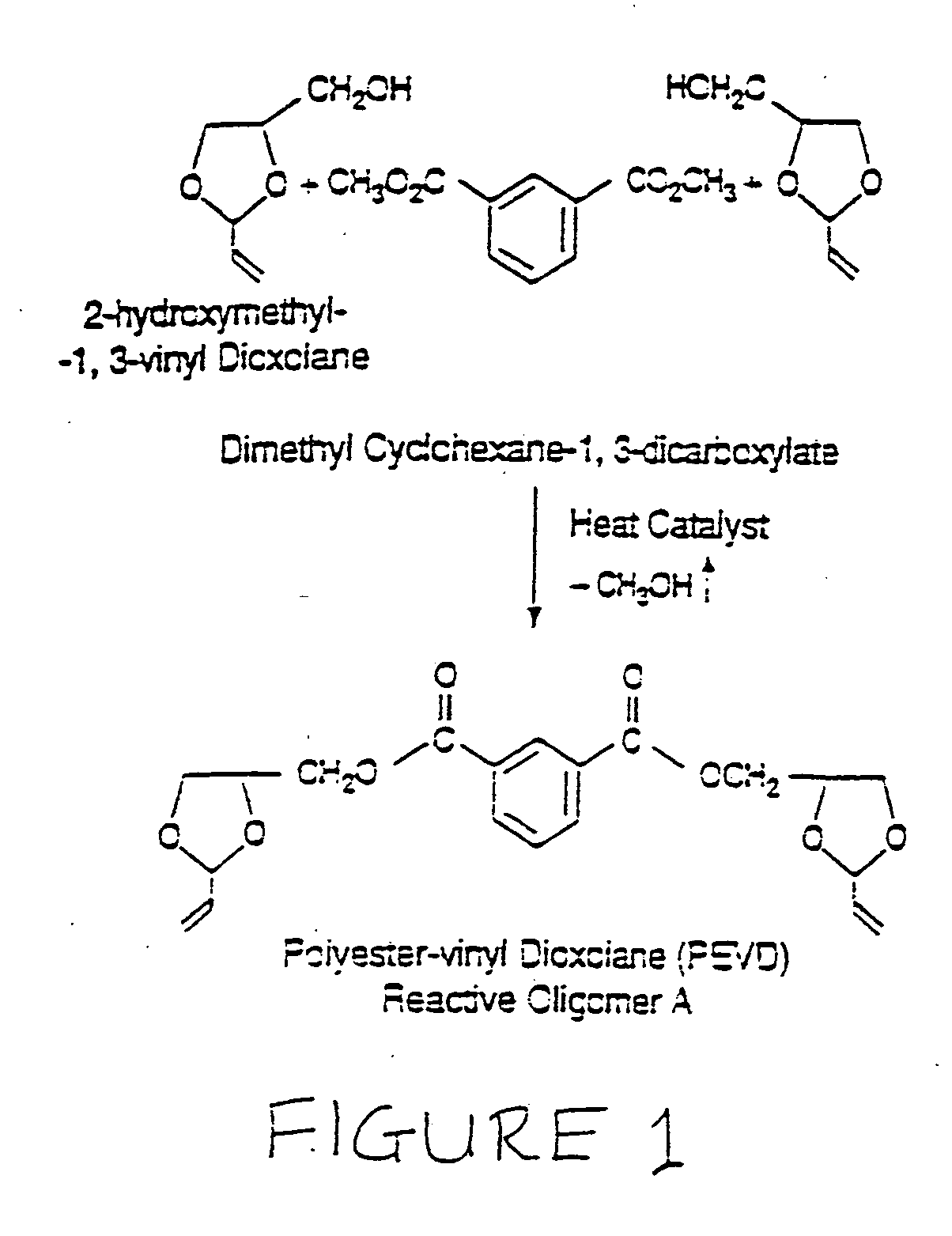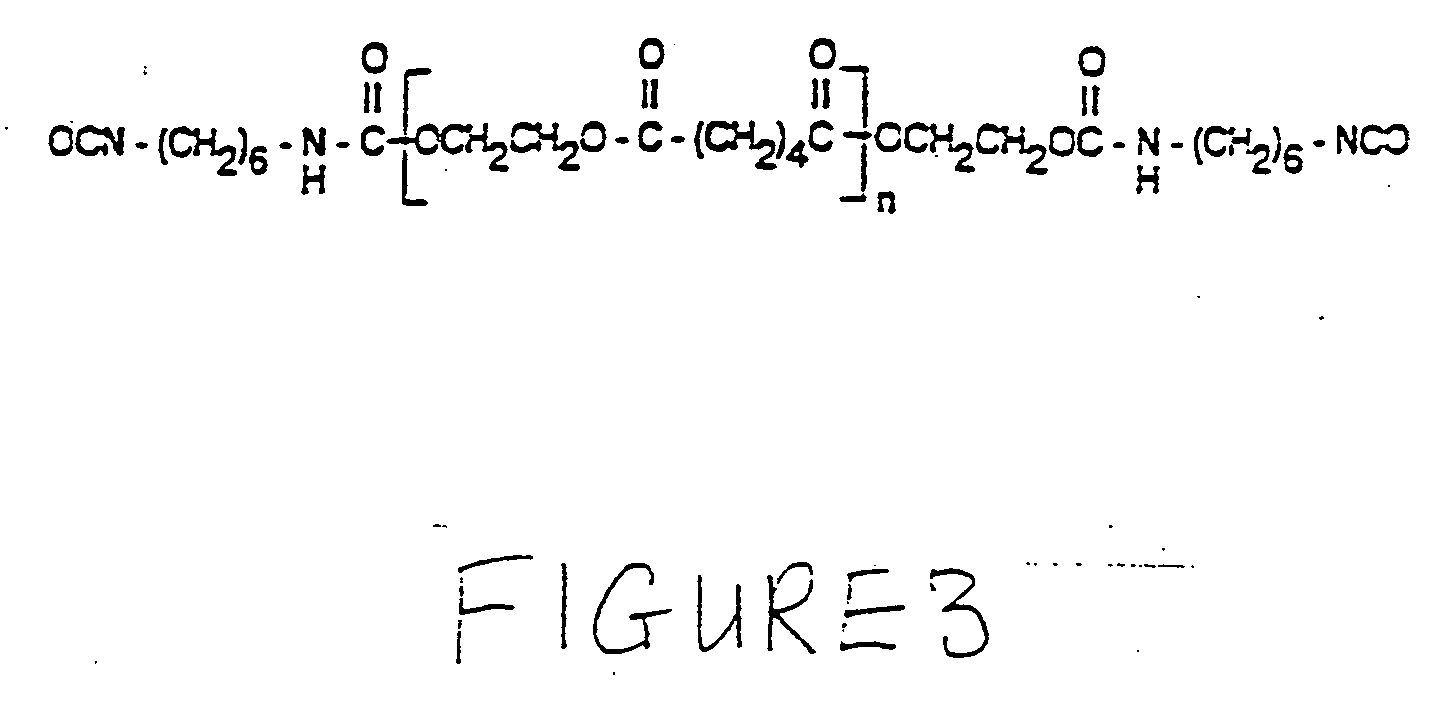No VOC radiation curable resin compositions with enhanced flexibility
- Summary
- Abstract
- Description
- Claims
- Application Information
AI Technical Summary
Benefits of technology
Problems solved by technology
Method used
Image
Examples
example 1
[0192] The effect of photoinitiator concentration on cure time and coating properties was studied in connection with PUVD (as formed by reacting TMXDI with HBVD). Sartomer KIP-100F, an alpha hydroxy ketone based photoinitiator that has high reactivity and low volatility was used in the experiments. The reactive diluent, diethylene glycol diacrylate (Sartomer SR-230) was added to lower the viscosity in some formulations. The cure results are set out below in Table 7.
TABLE 7Effect of UV Exposure TimeUVAdhesionHardnessExposureASTMD-ASTM D-FormulationTime (sec)3359-78.3363-92a.PUVD(95%) / KIP100F (5%)3955BPUVD(95%) / KIP100F (5%)621HBPUVD(95%) / KIP100F (5%)1261HPUVD(95%) / KIP100F (5%)250Failed2HPUVD(90%) / SR-230 (5%) / 3952BKIP100F (5%)PUVD(85%) / SR-230 (10%) / 392BKIP100F (5%)PUVD(70%) / SR-230 (25%) / 39FailedN / A BrittleKIP100F (5%)PUVD(90%) / SR-230 (5%) / 625FKIP100F (5%)
5 = Excellent;
1 = Poor
[0193] The results indicate that increasing UV exposure time leads to both an increase in hardness and a lo...
example 2
[0194] The effect of higher absorption photoinitiators on PUVD curable resin compositions (as formed by reacting TMXDI with HBVD) containing 5 weight % of a Sartomer SR-230 diethylene glycol diacrylate reactive diluent was studied. Coating thickness and UV-irradiation source was varied. The cure results are set out below in Table -8.
TABLE 8Evaluation of Higher Absorption Band Photoinitiators With UnpigmentedPUVD / SR-230 (5%) FormulationTimein UVMa-UVCoatingUVchine,ExposureCoatingPhotoinitiatorThicknesssourceminTime, secPropertiesKIP-100F, 5%2 milH bulb14Adherent,hardKT-046, 5%2 milH bulb14Adherent,softKT-046, 5%2 milD and H27Adherent,bulbssoftKT-046, 5%2 milV and H27Adherent,bulbssoftCIBA 8190.5 mil V and H27Adherent,(2.5%) andbulbshardCIBA 4265(2.5%)
example 3
[0195] The cure of PUVD resin compositions (as formed by reacting TMXDI with HBVD) having an added titanium dioxide pigment, were studied. Pigment incorporation requires high shear mixers for effective breakup of pigment compounds. Present experiments were carried out in small quantities and pigments were incorporated using an agate mortar and pestle. The mixture was grinded for about 3 minutes.
[0196] UV sources with higher spectral output were used to match the photoinitiator. Higher absorption band pigments necessitate the use of longer wavelength UV lamps for the cure of pigmented materials. Therefore, two such bulbs V and D, with spectral output greater than 300 nm, were obtained from Fusion UV Company. These bulbs were used by themselves or in combination with the conventional H bulb depending on the resin / pigment properties. In some cases, the V and D bulbs were used for the initial cure where the longer wavelength irradiation more readily penetrates into the depth of the coa...
PUM
| Property | Measurement | Unit |
|---|---|---|
| Temperature | aaaaa | aaaaa |
| Percent by mass | aaaaa | aaaaa |
| Percent by mass | aaaaa | aaaaa |
Abstract
Description
Claims
Application Information
 Login to View More
Login to View More - R&D
- Intellectual Property
- Life Sciences
- Materials
- Tech Scout
- Unparalleled Data Quality
- Higher Quality Content
- 60% Fewer Hallucinations
Browse by: Latest US Patents, China's latest patents, Technical Efficacy Thesaurus, Application Domain, Technology Topic, Popular Technical Reports.
© 2025 PatSnap. All rights reserved.Legal|Privacy policy|Modern Slavery Act Transparency Statement|Sitemap|About US| Contact US: help@patsnap.com



